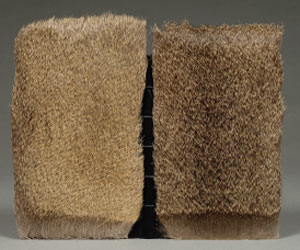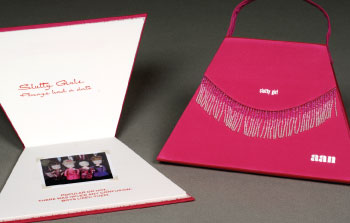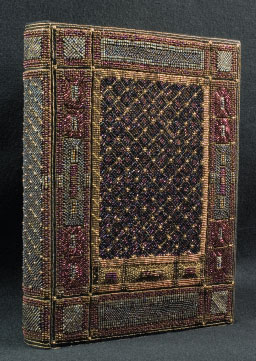
|
|
About Continuum Advertising Advisory Committee Archives Contact Us Continuum Home Faculty/Staff Subscribe related websites Alumni Association Marketing & Communications University of Utah Home |

BookshelfShowcasing the Art of the BookThree Utah artists are included in an exclusive juried exhibit of handmade books.by Marcia C. Dibble
One is covered in plush fur, another in hot pink fabric, the third with gold thread and beads. All are books—made by hand—and are included in the Guild of Book Makers’ current juried exhibition, coming to the Utah Museum of Fine Arts in February 2007. And all three are the creations of artists affiliated with the University of Utah’s Book Arts Program. Madelyn Garrett BA’82 MA’90, Marnie Powers-Torrey MFA’01, and Antonia “Toni” Nelson BFA’98 are among just 60 book artists from around the world with unique artist’s books juried into the Guild’s 100th Anniversary Exhibition, which opened October 2006 in New York City. And each of their pieces is not only dazzling, but cleverly conceived. Powers-Torrey, studio manager of the Book Arts Program at the J. Willard Marriott Library, says her piece “attempts to communicate, in content and as an object, the sensual experience of handling and reading a book.” Covered in buckskin, her creation is titled, appropriately, The Warm-Blooded Book. “The deer fur cover and title are unmistakable references to the life held within this or any book object,” she says. The debossed nature of the letterpress printing and the Roma laid paper—a handmade specialty paper with a slightly ribbed effect—also add to the book’s sensuousness. “And the leather spine over cords emphasizes the parallel nature of a book to a human skeletal system,” she notes. "This book is about the experience of holding a book, turning its pages," Powers-Torrey says, "so the interaction between reader and book is emphasized by the frequent page-turning required to experience it." The 48-page book features images of hands holding and handling books interspersed with lines of text about the experience of reading a book (excerpted here): A book first opened/ is reticent/ its spine unwilling/ to concede/ pages turning crisply/ but falling softly/ a book/ visited many times/ crackles open/ spine falling heavily/ pages turning/ with barely a sound within sentences/ the space/ between you/ and your book/ has narrowed/ and the real world/ gives way/ to a world more real/ where no screen exists/ between you/ and spirited pages/ of tactile memory “This book is about the experience of holding a book, turning its pages,” Powers-Torrey says, “so the interaction between reader and book is emphasized by the frequent page-turning required to experience it.” With books now in private and public collections around the country—she has created about 25 in all, six in multiples (editioned) and the others one of a kind—Powers-Torrey says, “Since I was a child, I have been enamored by the book form, stapling and otherwise roughly binding folded paper before I had a clue about traditional binding methods.” She recalls discovering the contemporary renaissance in book arts while a student at the School of the Museum of Fine Arts, Boston. “I took several book arts classes there and fell in love. When I entered graduate school in the Art and Art History Department at the U of U in 1998, I had no idea that the Book Arts Program was blossoming right next door. Once I took letterpress, I was hooked.” Powers-Torrey began volunteering for the program immediately, then joined the staff part time in 1999. She has worked full time as studio manager since 2001, and teaches letterpress printing, photopolymer plate printing, and other book arts for the program. Though she has served as co-chair of the Rocky Mountain Chapter of the Guild of Book Makers for the past five years, she had never entered a national Guild show before this one, which will be the third that the U has hosted.
Nelson says of her book, I Wish I’d Been A Slutty Girl Among Other High School Regrets—covered in pink prom dress fabric and designed in the form of a fringed handbag, opening from bottom to top—“I like to call it my ‘Athena Project.’ She [Athena] sprang fully formed from Zeus’s brain, and so did this.” The book is illustrated with photos of dolls Nelson played with as a child, dressed in new handmade costumes and posed in vignettes, such as contestants in a beauty pageant. That image is captioned: “Slutty girls didn’t like their bodies more than anyone else did, they just used them before it was too late.” The book was created in an edition of 21—“which means,” explains Nelson, “I have all the parts, and will probably spend the next year assembling them in between doing other books.” In describing the book’s form for the Guild exhibition, she wrote, “I like the challenge of making books that are innovative, but not so much a departure from the codex that they are not easily recognizable as a book. That they are fun is just a bonus.” Since discovering the book arts about six years ago (she is also a painter), Nelson has exhibited in multiple regional shows, receiving honors such as “Best use of unexpected materials” in the sculpture-as-book-themed exhibition “Stand & Deliver,” which traveled the country from California to Florida in 2005. She now teaches some of the craft through the Book Arts Program, and taught two beginning bookbinding courses in September 2006 at the Great Basin Fiber Arts Fair. She will offer a course on basic bookmaking to K-12 teachers in June 2007 as part of the Great Salt Lake Book Festival. “I love book art because it is so varied,” Nelson says. “It encompasses so many crafts: designing, writing, printing, illustrating, binding. It can even include making your own paper, and sewing—that’s my favorite part—each one its own skill. That’s the fun and the challenge.” The Marriott’s Book Arts Program has allowed her “to work with some of the best book artists in the country,” she says. “The program has maybe six workshops a year, and probably four of those will be with famous book workers from around the country. Madelyn [Garrett, head of Rare Books and founder of the Book Arts Program at the library] has an amazing ability to recruit the best people to our program.”
Garrett’s piece restores the antique tome The Art of the Book: a Review of Some Recent European and American Work in Typography, Page Decoration, and Binding, fine press printed in 1914. She cleaned, rebound, and resewed it, then created a new cover for it—an adaptation of a traditional panel binding from the 16th or 17th century—painstakingly sewing gold floss and Czech, Italian, and Japanese beads onto velveteen. The project took more than six months to complete; Garrett estimates that it required two hours of labor for each inch of the 9-x-12-inch cover. “I do a lot of experiments in binding and materials, like exploring what you can do with metal and silk together,” says Garrett, a bookmaker of many years (she herself has juried exhibitions, as well as having pieces featured in other shows). “Lately I’m doing mostly whimsical miniature books, so I’m spending a lot of time with magnifying glasses on these little teeny books.” But with her background in art history—she also lectures widely on the history of the book and the form’s continued relevance—“I still have strong references to the historical no matter what I do,” she says, “Artists can be very interested in the book form because it offers so many possibilities,” she observes. “I think this exhibit is one of the highlights of the last 10 years as visual confirmation of that. It’s showcasing such a wide range of creative possibilities. My book, for example, is painfully traditional. But you can move the entire gamut: Some are so sculptural, people standing in front of one could have a real debate—Is it a book or isn’t it?” Though Garrett notes that book artists now regularly combine using computers with older bookmaking techniques—for example, graphing out a design in a computer program, transferring the design to a polymer plate, then putting it on traditional letterpress—she doesn’t think reading an e-book on a laptop is likely to replace the traditional book anytime soon. “We love computers, but you’re never going to snuggle down in front of the fire with your favorite book on a computer screen,” she says. “There’s something about the ‘sequentialness’ of the pages as they turn, the texture of the paper, the feeling of the book binding, and the relationship of your eye and your hand…. For work or pleasure, there’s more to a book than reading words off a screen.” Garrett is understandably pleased to see three Utah book artists juried into such an exclusive exhibition as the Guild’s 100th Anniversary show, which includes exhibitors from all around the U.S. as well as Argentina, the U.K, Australia, and the Czech Republic. “I am very proud that we are going to be so well-represented. I think it says a lot about our Book Arts Program and about the Marriott Library,” she says. “The exhibition is traveling all over the country, and will be in some really nice venues. And our inclusion says good things about the U of U and book arts in Utah.” —Marcia C. Dibble is assistant editor of Continuum |

Spring 2007 Bookmaking EventsThe University’s Book Arts Program and the Utah Museum of Fine Arts are offering a number of lectures and classes in conjunction with The Guild of Book Workers exhibition, including a second exhibit of unique books created entirely by Utah artists. February 9 – March 18 February 9, 7-9 p.m. February 17 February 21 March 2-3 March 30-31 February 2-March 30
|


